3dsmax 9 - SPECapc 3dsmax CPU Rendering Test
Today's desktop processors are more than fast enough to do professional level 3D rendering at home. To look at performance under 3dsmax we ran the SPECapc 3dsmax 8 benchmark (only the CPU rendering tests) under 3dsmax 9 SP1. The results reported are the rendering composite scores:
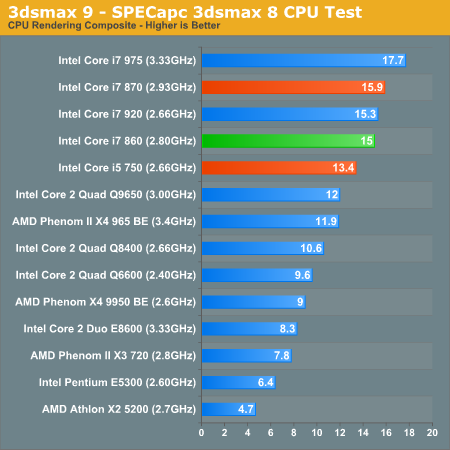
There are definitely cases where Bloomfield's memory controller is a boon, the Core i7 860 is able to approach but not outperform the i7 920.
Cinebench R10
Created by the Cinema 4D folks we have Cinebench, a popular 3D rendering benchmark that gives us both single and multi-threaded 3D rendering results.
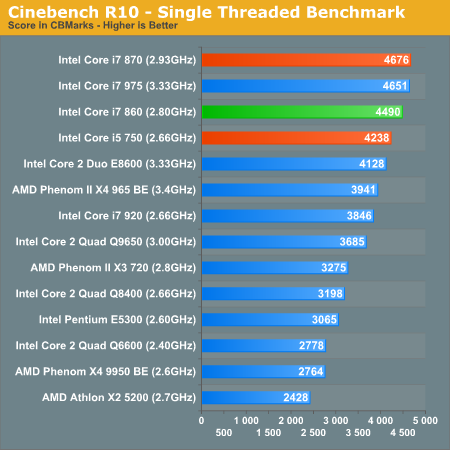
Since threaded performance is excellent on the 860, after all it's running at 3.46GHz in this situation. The 920 doesn't stand a chance.
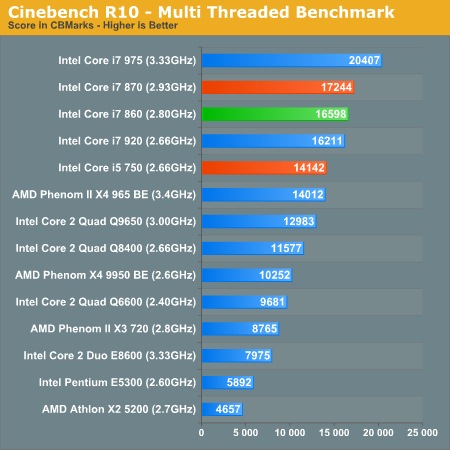
Up the thread count and we see the Core i7 860 slightly ahead of the 920.
Blender 2.48a
Blender is an open source 3D modeling application. Our benchmark here simply times how long it takes to render a character that comes with the application.
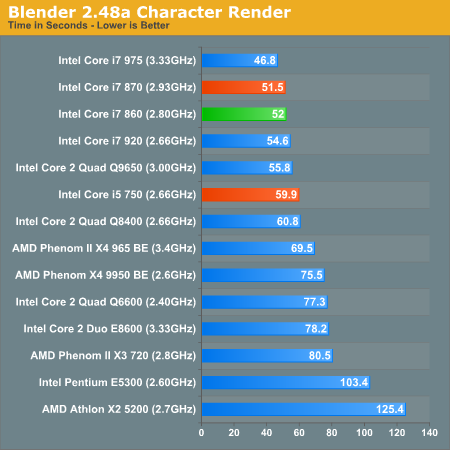
Blender performance is again faster than a 920 and nearly on par with the Core i7 870.
POV-Ray 3.73 beta 23 Ray Tracing Performance
POV-Ray is a popular, open-source raytracing application that also doubles as a great tool to measure CPU floating point performance.
I ran the SMP benchmark in beta 23 of POV-Ray 3.73. The numbers reported are the final score in pixels per second.
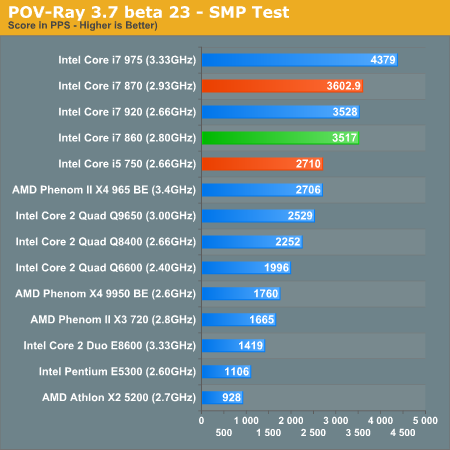
POV-Ray performance is nearly on par with the Core i7 870 and equal to that of the i7 920.










121 Comments
View All Comments
strikeback03 - Monday, September 21, 2009 - link
In previous tests Anand has used the fastest validated speed for each platform, so 1066 for Bloomfield and 1333 for Lynnfield. Not that it probably makes much difference in anything but synthetic benchmarks.Scheme - Saturday, September 19, 2009 - link
Woah, did you forget to take your ritalin last night?mesiah - Saturday, September 19, 2009 - link
Anand, can't you ban this guy? You have to be tired of watching him come on here and verbally assault any person he doesn't agree with, including yourself. Do everyone a favor and toss him to the curb.jonup - Sunday, September 20, 2009 - link
Noooo! This would be too cruel. We need a joker to make us laugh from time to time.tim851 - Saturday, September 19, 2009 - link
Let me guess, you have an i7 920...?Of course the 860 ran at higher clock speeds, why would Anand underclock it? It was compared to the 920 because they share the same price point. That is until you add the motherboard, then the i7 is like 100$ more expensive.
And Anand summed it up nicely: the 1366 platform is now for people who need hexa-cores someday or who think SLI/Crossfire is reasonable.
Oh, and if the P55 Platform is "braindamaged", then apparently all major tech sites are in on the conspiracy.
jordanclock - Saturday, September 19, 2009 - link
What do you mean by "inferior memory?"And of course the 860 was running at a higher clock rate: That's how it is designed to run. Even without Turbo.
TA152H - Saturday, September 19, 2009 - link
I don't have a problem with the 860 running at higher clock speeds, but if the architecture were better, it would never lose to a processor running at lower clock speeds.In short, the architecture is not clearly better. It's worse, the margin is the only thing worth discussing.
TA152H - Saturday, September 19, 2009 - link
I should have said, i7 920 still outperformed it in a few benchmarks.Pity there isn't an edit.
JumpingJack - Saturday, September 19, 2009 - link
The basic architecture of Lynnfield is the same as Bloomfield. The differences are the topology of the platform (PCI on die instead of in the chipset, 2 mem controllers instead of 3, no QPI in Lynnfield). The cores are exactly the same, the cache is exactly the same.jordanclock - Saturday, September 19, 2009 - link
I have yet to see any real world scenarios where triple channel memory "really shines." The inclusion or exclusion of a triple channel set up would account for variations of about 1% either way. In other words, less than the margin of error.